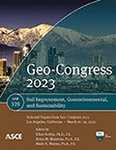Numerical Simulation of a Geothermal Bridge Deck Deicing System for Use in Montana
Publication: Geo-Congress 2023
ABSTRACT
This research will investigate the use of a ground-source bridge deck deicing system, to remove snow and ice and mitigate temperature fluctuations within concrete bridge decks for Montana weather conditions. Temperature fluctuations lead to the deterioration of concrete. Damage from these fluctuations is especially prevalent in concrete bridge decks in Montana where there are many freeze-thaw cycles throughout the year. Time histories of weather data from 73 road weather information system stations throughout the state were collected over the period of 2015 to 2020 and used to develop a range of winter events to replicate in a numerical model. The numerical model of a bridge deck with embedded heat exchanger pipes was constructed in COMSOL Multiphysics and used to evaluate the feasibility of using a geothermal bridge deck deicing system when exposed to severe winter events. Results from a series of model bridge deck heating experiments available in literature were used to validate the numerical model. Preliminary results show that a geothermal bridge deck deicing system can successfully bring the bridge deck surface temperature above freezing during severe Montana winter events. However, ground-source bridge deck deicing systems will likely not eliminate the need for other snow and ice removal and prevention strategies. The most effective solution will likely include a combination of available methods.
Get full access to this article
View all available purchase options and get full access to this chapter.
REFERENCES
Al-Kaisy, A., and Ewan, L. (2017). Prioritization scheme for proposed road weather information system sites: Montana case study. Frontiers in built environment, 3, 45.
ASHRAE (American Society of Heating Refrigerating and Air-Conditioning Engineers). (1999). ASHRAE Handbook - Fundamentals (SI Edition), American Society of Heating, Refrigerating and Air-Conditioning Engineers, Inc.
Baboian, R. (1992). Synergistic effects of acid deposition and road salts on corrosion. In Corrosion forms and control for infrastructure (pp. 17–29). ASTM International.
Balbay, A., and Esen, M. (2013). Temperature distributions in pavement and bridge slabs heated by using vertical ground-source heat pump systems. Acta Scientiarum. Technology, 35(4), 677–685.
Bowers, G. A., Jr. (2016). Ground-source bridge deck deicing and integrated shallow geothermal energy harvesting systems [Doctoral dissertation, Virginia Tech].
Chapman, W. P. (1952). Design of snow melting system. Heating and Ventilating, (49) 4: 95–102.
Chen, X., Kong, G., Liu, H., Yang, T., and Zhu, X. (2020). Experimental on thermal performance of bridge deck with hydronic heating system. Cold regions science and technology, 178, 103130.
Ghasemi-Fare, O., and Basu, P. (2016). Predictive assessment of heat exchange performance of geothermal piles. Renewable Energy, 86, 1178–1196.
Granata, R., and Hartt, W. H. (2009). Integrity of infrastructure materials and structures. U.S.D.o.T. FHWA, ed., FHWA, U.S. Department of Transportation, United States, 90p.
Kelting, D. L., and Laxon, C. L. (2010). Review of effects and costs of road de-icing with recommendations for winter road management in the Adirondack Park. Adirondack Watershed Institute.
Kusuda, T., and Achenbach, P. R. (1965). Earth temperature and thermal diffusivity at selected stations in the United States. National Bureau of Standards Gaithersburg MD.
Liu, X. (2005). Development and experimental validation of simulation of hydronic snow melting systems for bridges [Doctoral dissertation, Oklahoma State University].
Virmani, Y., Clear, K., Pasko, T., Jr., Jones, W., and Jones, D. (1983). Time-to-corrosion of reinforcing steel in concrete slabs. Volume 5: Calcium nitrite admixture or epoxy-coated reinforcing bars as corrosion protection systems. STIN, 84, 32578.
Virmani, Y. P., Jones, W. R., and Jones, D. H. (1984). pH at Corrosion Sites. Public Roads, 48(3), 96–102.
White, D., Sritharan, S., Suleiman, M. T., and Chetlur, S. (2005). Identification of the best practices for design, construction, and repair of bridge approaches.
Yu, X., Hurley, M. T., Li, T., Lei, G., Pedarla, A., and Puppala, A. J. (2020). Experimental feasibility study of a new attached hydronic loop design for geothermal heating of bridge decks. Applied Thermal Engineering, 164, 114507.
Yunovich, M., Thompson, N., and Virmani, Y. P. (2003). Life cycle cost analysis for reinforced concrete bridge decks. CORROSION 2003, San Diego, California, 03309.
Information & Authors
Information
Published In
History
Published online: Mar 23, 2023
Authors
Metrics & Citations
Metrics
Citations
Download citation
If you have the appropriate software installed, you can download article citation data to the citation manager of your choice. Simply select your manager software from the list below and click Download.
Cited by
- Ethan Turner, Mohammad Khosravi, Kirsten Matteson, Kathryn Plymesser, Pooria Toomani, Ladean McKittrick, Jeff Jackson, Application of Geothermal Bridge Deck Deicing Systems to Mitigate Concrete Deterioration from Temperature Fluctuation: Model Scale Experiments, Journal of Bridge Engineering, 10.1061/JBENF2.BEENG-6795, 29, 8, (2024).
